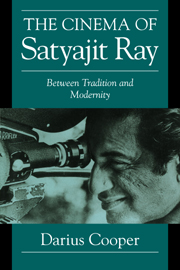Book contents
- Frontmatter
- Contents
- List of Illustrations
- Acknowledgments
- Introduction
- 1 Between Wonder, Intuition, and Suggestion: Rasa in Satyajit Ray's The Apu Trilogy and Jalsaghar
- 2 From Gazes to Threat: The Odyssean Yatra (Journey) of the Ray Woman
- 3 The Responses, Trauma, and Subjectivity of the Ray Purush (Man)
- 4 Satyajit Ray's Political Vision of the Doubly Colonized
- 5 From Newly Discovered Margins: Ray's Responses to the Center
- Notes
- Selected Bibliography
- Filmography
- Index
1 - Between Wonder, Intuition, and Suggestion: Rasa in Satyajit Ray's The Apu Trilogy and Jalsaghar
Published online by Cambridge University Press: 05 June 2012
- Frontmatter
- Contents
- List of Illustrations
- Acknowledgments
- Introduction
- 1 Between Wonder, Intuition, and Suggestion: Rasa in Satyajit Ray's The Apu Trilogy and Jalsaghar
- 2 From Gazes to Threat: The Odyssean Yatra (Journey) of the Ray Woman
- 3 The Responses, Trauma, and Subjectivity of the Ray Purush (Man)
- 4 Satyajit Ray's Political Vision of the Doubly Colonized
- 5 From Newly Discovered Margins: Ray's Responses to the Center
- Notes
- Selected Bibliography
- Filmography
- Index
Summary
To my “Hari” and “Sarbojaya” – my father and mother; my “Durga” – my sister and her family; and my “Apu” of fourteen years, Nikhil, who many times behaves like a zamindar
RasaTheory: An Overview
Although Satyajit Ray had a Western education and was deeply influenced by occidental modes of filmmaking – namely, Hollywood, the French cinema, and Italian neorealism – it is very important to remember that he was equally influenced by Indian culture and the various art forms, especially during his prolonged studies at Tagore's Fine Arts Academy at Santiniketan. As Ray describes it, such a fusion between the East and West should be considered
as a strength all along. But you have to have the backing of your own culture very much. Even when I made my first film the awareness was there. I had a western education. I studied English, but more and more over the last ten years I have been going back to the history of my own country, my people, my past, my culture. …
Ray's early films provide us with a rich evidence of this, especially in his handling of the elaborate and often intricate theories of rasa as laid down by classical Sanskrit theoreticians like Dandin (seventh century), Anandvardhana (ninth century), and Abhinavagupta (tenth century).
Information
- Type
- Chapter
- Information
- The Cinema of Satyajit RayBetween Tradition and Modernity, pp. 15 - 74Publisher: Cambridge University PressPrint publication year: 2000
